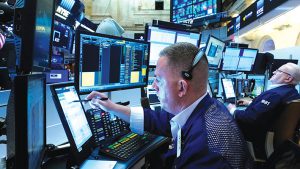BLOOMBERG
US equity futures rose on Monday, signalling a modest bounce for stocks on Wall Street after a bruising August so far for investors. Bonds were broadly weaker. Contracts for the S&P 500 and the Nasdaq 100 advanced, with the underlying gauges set to trim three weeks of declines. Palo Alto Networks Inc rallied in premarket trading after the cybersecurity company’s billings forecast beat estimate. European stocks rebounded from a six-week low as higher energy prices buoyed oil producers like TotalEnergies SA and Shell Plc.
European benchmark gas prices soared as much as 18% as traders priced in the possibility of supply disruptions from a potential strike in Australia. Global benchmark Brent traded above $85 a barrel, and is up more than 2% since last Wednesday’s close.
Treasury yields climbed across tenors, bringing the 10-year’s back on its path towards the highest level since November 2007 and the 30-year’s near 2011 highs, as a selloff in the market this month wiped out what was left of year-to-date gains.
The upturn for stocks follows a run of sharp declines, with the S&P 500 down 4.8% this month. Investors seeking clues on the global interest-rate outlook are turning their attention to this week’s annual gathering of central bankers at Jackson Hole, Wyoming, with Federal Reserve Chairman Jerome Powell due to speak on Friday.
“The Fed have done almost everything they need to do to get inflation down to target and it would surprise me if there was a lot more rate rises to come,” said David Henry, investment manager at Quilter Cheviot.
Powell is expected to strike “a more balanced tone in Wyoming, hinting at the tightening cycle’s end while underscoring the need to hold rates higher for longer,” according to Anna Wong at Bloomberg Economics. On the earnings front, the week’s key event is Wednesday’s report from Nvidia Corp, the chipmaker whose blowout revenue forecast helped ignite this year’s rally in artificial intelligence-linked stocks.
In contrast with Monday’s gains in European stocks and US futures, the mood was darker in Asia. A gauge of the region’s stocks dropped for the seventh day in the longest losing streak since June 2022, while shares in mainland China fell 1.4%. Confusion over China’s approach to stemming the nation’s property slump strained sentiment. Chinese lenders cut the one-year loan prime rate by 10 basis points and kept the five-year prime loan rates unchanged even after policymakers called for more lending. Traders had expected a 15-basis-point cut on both rates.
Elsewhere, a gauge of dollar strength was little changed. The offshore yuan fell against the greenback. The People’s Bank of China had earlier set the daily reference rate for the yuan at a level stronger than the average estimate in a Bloomberg survey.
 The Gulf Time Newspaper One of the finest business newspapers in the UAE brought to you by our professional writers and editors.
The Gulf Time Newspaper One of the finest business newspapers in the UAE brought to you by our professional writers and editors.
